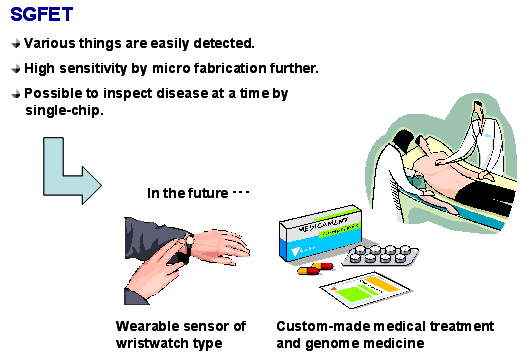|
Because the diamond transistor works in liquor, we are researching the application of it as biosensor. We already make and have evaluated a lot of biosensor. It explains the details on each researcher's page. It introduces the diamond transistor that becomes the base here.
What is biosensor ?
The definition of biosensor is various. For instance, it is the one using an advanced function or bimolecular of the living thing. The method of detection is also various, for instance, method of seeing object putting up fluorescent marker and it is detection of the change in the electric current or light.
Our biosensor is a device that detects the DNA and the ion, etc. by fixing the bimolecular to the transistor, and using the function. We are making the sensor that can detect the DNA, the ion in liquor, and the change in the pH. This is called SGFET (electrolyte Solution-Gate FET) in our laboratory. |
|
Feature of SGFET ?
It can detect the object in liquor directly. In the detection of the DNA, the fluorescent marker is usually introduced, and the fluorescence microscope that can be used only in the darkroom is necessary. In addition, there is something with the radioactivity in the fluorescent marker so its handling is difficult and the cost is high. Other methods have a similar problem.
However, SGFET can detect the change in the electric charge in liquor directly. Everyone can easily use it anywhere as long as there is a source meter. Moreover, there is an advantage only of the diamond and FET described later, too.
Advantage of use of diamond ?
The diamond is a stable extremely material. It is an advantage of this stability that the transistor works in water. The potential window of the diamond is wide.
In general, the transistor that uses the Si also has the one that operates similarly in liquor. However, it doesn't operate as it is to say nothing of a usual transistor in liquor. Therefore, the process becomes complex as the insulation film is applied to the gate part. It operates even if not working like this in the diamond transistor. This becomes a big advantage when being commercialize in the future.
The cost is not high. Isn't its cost high though it is a diamond? It is not a diamond of large, thick, crystalline, high nature like the jewel but a polycrystalline film of the diamond that artificial synthesized from the methane is thin to use. The diamond can be synthesized for myself in the laboratory, and a very cheap sensor can be made
|
|
What can you detect in SGFET ?
It succeeds in the development of the glucose sensor and the urea sensor that has fixed the enzyme to the investigation of the sensitivity to the pH of SGFET and the halide ion and gates up to now in this laboratory. The detection such as the DNA, RNA, and calcium ions is being researched now. Moreover, it began to start the development of a new sensor that used the cell.
Possibility of SGFET in the future
There are still a lot of materials that want to be detected. Hereafter, the detection object will be expanded because various the one can be detected when the one fixed to the gate is changed.
Moreover, because it is a sensor that uses FET, it is possible to make it minutely. The sensing part has already succeeded in the development of about 1/100 sensors. Because the more it reduces it in FET, the more the detectivity rises, it is thought that detecting a variety of kinds of materials on the single-chip becomes possible. Then, the condition can be checked by using urine and blood. It is likely to be able to apply it to the custom-made medical treatment and the genome medicine manufacture.
|
References
[1] K. S. Song, G. J. Zhang, Y. Nakamura, K. Furukawa, T. Hiraki, J. H. Yang, I.Ohdomari, H. Kawarada "Label-free DNA sensors using diamond FETs", Phys. Rev. E, 74 (4), 041919 (2006)
[2] K. S. Song, T. Hiraki, H. Umezawa, H. Kawarada "Miniaturized diamond field-effect transistors for application in biosensors in electrolyte solution", Appl. Phys. Lett. 90, 6, 063901 (2007)
[3] S. Kuga, J. H. Yang, H. Takahashi, K. Hirama, T. Iwasaki, H. Kawarada "Detection of mismatched DNA on partially negatively charged diamond surface by optical and potentiometric methods", J. Am. Chem. Soc., 130, 13251-13263 (2008)
[4] S. Kuga, S. Tajima, J.H. Yang, K. Hirama, H. Kawarada, "Precise Detection Of Single Mismatched DNA With Functionalized Diamond Electrolyte Solution Gate FET", Tech. Dig. IEEE IEDM, p483 (2008)
|


